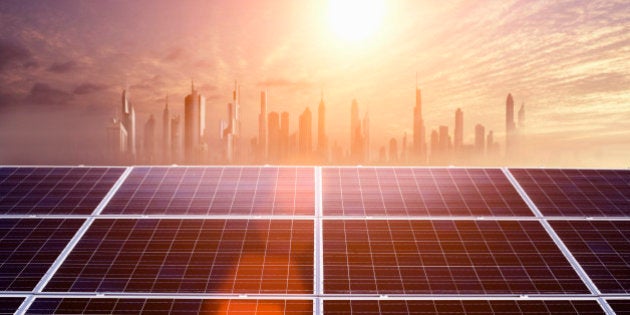
The biggest policy item on President Barack Obama's second term is to deal with the consequences of climate change. Often we hear him chart out the reasons why tackling climate change is such a top priority for his administration, but when it comes to offering a vision commensurate with the challenge, he keeps missing the big opportunity.
But finally, in order to tackle all these problems that he articulates, there is this exciting new idea--Space-Based Solar Power (SBSP), which entails tapping sunlight in space to generate clean constant energy. It is this idea that won the top prize for innovation in technology for a clean and truly prosperous world at the D-3 (Diplomacy, Defense and Development) summit on 2 March in Washington, D.C. The D-3 saw 500 idea submissions across the US. Out of these, only six were selected for the finals. The Space-based Solar Power idea took the top four of the seven prizes (for innovation, collaboration, presentation and people's choice). Could this idea be as revolutionary as the Wright Brothers' paper plane that gave us modern aviation? Perhaps!
Interestingly, in August 2008, Dr APJ Kalam... specified that SBSP has the potential to offer 24 hours "perennial supply of renewable energy from space."
Interestingly, in August 2008, former President of India, Dr APJ Kalam in his speech at Boston University, 'The Future of Space Exploration and Human Development' cautioned that with an increase in world population to 9 billion by 2050, there would be shortage of energy, water, and increasing damage on the ecology. While warning that "civilization on earth will run out of fossil fuels in this century," Dr Kalam specified that SBSP has the potential to offer 24 hours "perennial supply of renewable energy from space," At that time, Dr Kalam had recognized the absence of fully reusable space transportation as the reason humankind has not benefitted from SBSP in geo-stationary and other orbits yet.
Seven years later, in December 2015, we witnessed the successful return of Space X's Falcon 9 to Cape Canaveral, demonstrating the scope to reuse space transportation. So, the re-use space technology that Kalam identified as key for mankind to benefit from SBSP now exists and will only be further replicated as we go forward. In 2013, Dr Kalam and Mark Hopkins, chairman of the Executive Committee of the National Space Society (NSS) released a joint statement that identified the need for global collaboration in space to meet the challenges faced by earth due to depleting resources and climate change. In the statement, both stated that the NSS and Indian space experts have worked together over the years to realize the untapped and enormous potential of SBSP, especially through US-India and other international collaboration.
Given space has no atmosphere, is never cloudy, and when in geosynchronous orbit there is no night, the power generated by a SBSP satellite will be constant.
So, what exactly is SBSP? It is a technology that taps the sun's energy on orbit and delivers it wirelessly to Earth. SBSP is clean, global and it is renewable. What is more, given space has no atmosphere, is never cloudy, and when in geosynchronous orbit there is no night, the power generated by a SBSP satellite will be constant. SBSP locates satellites in the geosynchronous orbit which are far enough from the Earth that they don't fall under our planet's shadow except for very brief periods (spring and fall equinoxes) of less than an hour. Placed high above the atmosphere at a distance of about 35,800 km above the Earth's equator, the SBSP satellites can intercept rays 70% more intense than the midday sun on earth. This means the space based photovoltaic cell will generate 40 times more power annually than an Earth-based solar cell. Once generated, the electric current can be transmitted back to receiving antennas on earth either through an infrared laser beam or as microwaves which can easily pass through cloud cover. Individual SBSP satellites are capable of transmitting power to a receiving station anywhere on the globe. By 2100, the world will require about 70TW of energy, and the geostationary belt alone has the capacity to generate 332TW of energy, which will facilitate a developed world with zero carbon energy emissions.
The geostationary belt alone has the capacity to generate 332TW of energy, which will facilitate a developed world with zero carbon energy emissions...
One of the biggest challenges globally now is to mitigate the impact of climate change and thus . The world is thereby urgently looking to renewables. India is itself aiming to spend heavily on ground solar for its expanding energy needs, given it will be the second largest economy by 2050. However, its former President Dr. Kalam grasped the significance of a 24-hour SBSP, not just for India but for global prosperity as early as 2007-08. A 2007 Pentagon report had urged India to invest in SBSP. In that light, it is rather exciting that with the D-3 summit, this idea for SBSP has been recognized within the highest realms of the US government. Which means that there will only be growing investment on the development of SBSP in the near and long-term future.
China and Japan are already far ahead and are investing heavily on SBSP. Japan is actually the furthest in enjoying the benefits of SBSP. In March 2015, Japan's Aerospace Exploration Agency, or Jaxa, successfully transmitted electric power wirelessly to a pinpoint target utilizing microwaves. This is the base technology that will be required for the transmission of SBSP. The most compelling factor about SBSP is that it can transmit power round the clock, and it is not affected by changing weather conditions as the sun rays are captured before they enter the earth's eco-system. According to Jaxa, "A receiver set up on Earth with an approximately 3-kilometer, or 1.9-mile, radius could create up to one gigawatt of electricity, which is about the same as one nuclear reactor." Jaxa's success in transmitting electricity wirelessly solved the biggest technological challenge that SBSP confronted: how to transmit energy from a space-based solar satellite to Earth.
India, too, is poised to take advantage of some of the revolutionary new developments in the SBSP field given its own highly developed space program.
In addition, China, the leading economic super power by 2050, has already established a national mission to tap Space-Based Solar Power.
India, too, is poised to take advantage of some of the revolutionary new developments in the SBSP field given its own highly developed space program. The nation could collaborate with the US and Japan to further strengthen the SBSP infrastructure. I envision that the future of SBSP will follow an arc similar to that of the internet. Developed by the U.S. Defense Research and Development Agency (DARPA) for a small group of people for internal communications via computers (ARPANET), the internet has now become global commodity, connecting billions cheaply and empowering all those who have access to it. I foresee the same kind of journey for SBSP and believe that our journey to saving the planet is finally getting started.



Contact HuffPost India
Also see on HuffPost:
